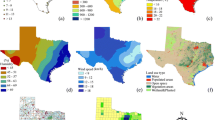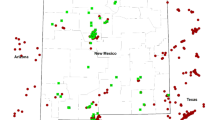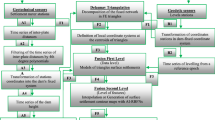Abstract
This paper shows the versatility of artificial neural networks (ANN) and radial basis functions (RBF) applied to electromagnetic analyses with Medium Wave samples. A new approach is given from an exposure point of view, analyzing field levels in wide areas. In particular supervised ANN are used to distinguish electromagnetic field areas, if levels are above or below a certain threshold. The novel application Electric-Frontier ANN (EF-ANN) allows us to compare the performances of different neural network topologies (linear and recurrent), and it also gives us the possibility to create maps via geographic information systems (GISs). Furthermore another designed application, Electric-Interpolation RBF (EI-RBF), is used to obtain interpolated maps of electric field levels in the environment under study, with excellent performances, and having the possibility of overlapping the results with the local cartography in GIS. The interest of these developed tools is to identify the areas where the levels are higher from an exposure standpoint, and to know how the distribution of levels is in a real environment, but using exclusively experimental samples which are more reliable than simulations.








Similar content being viewed by others
References
ICNIRP (1998) Guidelines for limiting exposure to time-varying electric, magnetic, and electromagnetic fields (up to 300 GHz). Health Phys Soc 74. International Commission on Non-Ionizing Radiation Protection
ECC (2007) Measuring non-ionising electromagnetic radiation (9 kHz–300 GHz). ECC/REC/(02)04. Electronic Communications Committee, Helsinki
Baltrėnas P, Buckus R (2013) Measurements and analysis of the electromagnetic fields of mobile communication antennas. Measurement 46(10):3942–3949
Oliveira C, Sebastiao D, Carpinteiro G, Correia LM, Fernandes CA, Serralha A, Marques N (2007) The moniT project: electromagnetic radiation exposure assessment in mobile communications. IEEE Antennas Propag Mag 49(1):44–53
Miclaus S, Bechet P, Gheorghevici M (2013) Long-term exposure to mobile communication radiation: an analysis of time-variability of electric field level in GSM900 downlink channels. Radiat Prot Dosimetry 154(2):164–173. doi:10.1093/rpd/ncs169
Qin Q-Z, Chen Y, Fu T-T, Ding L, Han L-L, Li J-C (2012) The monitoring results of electromagnetic radiation of 110-kV high-voltage lines in one urban location in Chongqing P.R. China. Environ Monit Assess 184(3):1533–1540. doi:10.1007/s10661-011-2058-y
Stam R (2011) Comparison of international policies on electromagnetic fields (power frequency and radiofrequency fields). National Institution for Public Health and the Environment. Ministry of Health. Welfare and Sport, Bilthoven
ICNIRP (2009) Exposure to high frequency electromagnetic fields, biological effects and health consequences (100 kHz–300 GHz). ICNIRP 16/2009, vol ICNIRP 16/2009. International Commission on Non-Ionizing Radiation Protection, Oberschleißheim
Uusitupa T, Laakso I, Ilvonen S, Nikoskinen K (2010) SAR variation study from 300 to 5000 MHz for 15 voxel models including different postures. Phys Med Biol 55:1157–1176
Shields N, O’Hare N, Gormley J (2004) An evaluation of safety guidelines to restrict exposure to stray radiofrequency radiation from short-wave diathermy units. Phys Med Biol 49:2999–3015
Mantiply ED, Pohl KR, Poppell SW, Murphy JA (1997) Summary of measured radiofrequency electric and magnetic fields (10 kHz to 30 GHz) in the general and work environment. Bioelectromagnetics 18:563–577
Dastorani M, Moghadamnia A, Piri J, Rico-Ramirez M (2010) Application of ANN and ANFIS models for reconstructing missing flow data. Environ Monit Assess 166(1–4):421–434
Tabari H, Marofi S, Abyaneh HZ, Sharifi MR (2010) Comparison of artificial neural network and combined models in estimating spatial distribution of snow depth and snow water equivalent in Samsami basin of Iran. Neural Comput Applic 19(4):625–635
Bishop CM (2005) Neural networks for pattern recognition. Oxford University Press, New York
Widrow B, Winter R (1988) Neural nets for adaptive filtering and adaptive pattern recognition. Computer 21(3):25–39
Feng L, Hong W (2009) Classification error of multilayer perceptron neural networks. Neural Comput Applic 18(4):377–380
Haykin S (2005) Neural networks. A comprehensive foundation. Pearon, Prentice Hall
Wang Z, Wang Y, Xuan J, Dong Y, Bakay M, Feng Y, Clarke R, Hoffman EP (2006) Optimized multilayer perceptrons for molecular classification and diagnosis using genomic data. Bioinformatics 10:755–761
Zhao C, Zhang B, Zhang X, Zhao S, Li H (2013) Recognition of driving postures by combined features and random subspace ensemble of multilayer perceptron classifiers. Neural Comput Applic 22(1):175–184. doi:10.1007/s00521-012-1057-4
Khashman A (2009) Application of an emotional neural network to facial recognition. Neural Comput Applic 18(4):309–320
Er MJ, Wu S, Lu J, Toh HL (2002) Face recognition with radial basis function (RBF) neural networks. IEEE Trans Neural Netw 13(3):697–710
Lo S-CB, Chan H-P, Lin J-S, Li H, Freedman MT, Mun SK (1995) Artificial convolution neural network for medical image pattern recognition. Neural Netw 8(7):14
Buhmann MD (2004) Radial basis functions: theory and implementations. Cambridge Monographs on Applied and Computational Mathematics. Cambridge University Press, Cambridge
Yu DL, Yu DW (2007) A new structure adaptation algorithm for RBF networks and its application. Neural Comput Applic 16(1):91–100
Harpham C, Dawson CW (2006) The effect of different basis functions on a radial basis function network for time series prediction: a comparative study. Neurocomputing 69:2161–2170
Lee YJ, Yoon J (2010) Nonlinear image upsampling method based on radial basis function interpolation. IEEE Trans Image Process 19(10):1982–2692
Vu P, Fasshauer GE (2011) Application of two radial basis function-pseudospectral meshfree methods to three-dimensional electromagnetic problems. IET Sci Meas Technol 5(6):206–210. doi:10.1049/iet-smt.2010.0125
Thoen B (1995) Internet resources for the geosciences, with an emphasis on GIS and mapping. Comput Geosci 21(6):779–786
Zhang C (2007) Fundamentals of environmental sampling and analysis. John Wiley and Sons, Hoboken
Rauscher C (2001) Fundamentals of spectrum analysis. Rohde-Schwarz, München
Carobbi CFM, Cati M, Panconi C (2009) Reproducibility of radiated emissions measurements in compact, fully anechoic, rooms—the contribution of the site-to-site variations. IEEE Trans Electromagn Compat 51(3):574–582
Carobbi CFM, Cati M, Panconi C (2011) Note on the expected value and standard deviation of the mismatch correction. IEEE Trans Electromagn Compat 53(4):1098–1099
Harris IA, Eng C, Warner FL (1981) Re-examination of mismatch uncertainty when measuring microwave power and attenuation. IEE Proc 128(1):35–41
Ministry S (2002) Orden CTE/23/2002, de 11 de enero, por la que se establecen condiciones para la presentación de determinados estudios y certificaciones por operadores de servicios de radiocomunicaciones. Orden CTE/23/2002. Boletín Oficial del Estado (BOE), Madrid
Becker S, Feldkamp LA, Haykin S, Ghahramani Z, Nelson AT, Patel GS, Puskorius GV, Racine R, Roweis ST, van der R Merwe, Wan EA (2001) Kalman filtering and neural networks. John Wiley & Sons, New York
Hornik K (1989) Multilayer feedforward networks are universal approximators. Neural Netw 2:359–366
Paniagua JM, Rufo M, Jiménez A, Antolín A, Sánchez M (2009) Electrical stimulation vs thermal effects in a complex electromagnetic environment. Sci Total Environ 407:4717–4722. doi:10.1016/j.scitotenv.2009.04.034
Gosselin M-C, Vermeeren G, Kühn S, Kellerman V, Benkler S, Uusitupa TMI, Joseph W, Gati A, Wiart J, Meyer FJC, Martens L, Nojima T, Hikage T, Balzano Q, Christ A, Kuster N (2011) Estimation formulas for the specific absorption rate in humans exposed to base-station antennas. IEEE Trans Electromagn Compat 53(4):909–922
Joseph W, Frei P, Roösli M, Thuróczy G, Gajsek P, Trcek T, Bolte J, Vermeeren G, Mohler E, Juhász P, Finta V, Martens L (2010) Comparison of personal radiofrequency electromagnetic field exposure in different urban areas across Europe. Environ Res 110:658–663
Zhang GP (2000) Neural networks for classification: a survey. IEEE Trans Syst Man Cybern C Appl Rev 30(4):451–462
Bourlier C, Kubické G (2011) Ground wave propagation along an inhomogeneous rough surface in the HF band: Millington effect for a flat Earth. IEEE Trans Geosci Remote Sens 49(4):1374–1382
Seybold JS (2005) Introduction to RF propagation. John Wiley and Sons, Hoboken
Zhang W (2007) Pattern classification and recognition of invertebrate functional groups using self-organizing neural networks. Environ Monit Assess 130(1–3):415–422
Wöhler C, Anlauf JK (1999) A time delay neural network algorithm for estimating image-pattern shape and motion. Image Vis Comput 17:281–294
Chandrasekaran V, Liu Z-Q (1998) Topology constraint free fuzzy gated neural networks for pattern recognition. IEEE Trans Neural Netw 9(3):483–502
Corne SA (1996) Artificial neural networks for pattern recognition. Concepts Magn Reson 8(5):303–324
Rogers SK, Colombi JM, Martin CE, Gainey JC, Fielding KH, Burns TJ, Ruck DW, Kabrisky M, Oxley M (1995) Neural networks for automatic target recognition. Neural Netw 8(7/8):1153–1184
Roth MW (1990) Survey of neural network technology for automatic target recognition. IEEE Trans Neural Netw 1(1):28–43
Walpole RE, Myers RH, Myers SL, Ye K (2007) Probability and statistics for engineers and scientists. Pearson Educatio, Pearson
Acknowledgments
This work was supported in part by the ‘Gobierno de Extremadura (Consejería de Empleo, Empresa e Innovación)’ and the ‘European Social Fund’.
Author information
Authors and Affiliations
Corresponding author
Appendices
Appendix 1: Parameters to measure the ANN suitability
When presenting the results, we can use different parameters to measure the suitability of the network. On the one hand, for the training process, we use the following ones:
-
MSE: Mean squared normalized error function given by Eq. (6), where r refers to the number of neurons in the output layer, N computes the number of patterns which are being used in the network, d is the desired output for each pattern in that layer, and y is the output of the network obtained for each one. It measures the performances of the network according to the mean of squared errors.
On the other hand, if we are interesting in calculating the performance of the network, by comparing how the correspondence between original values and those predicted or simulated by the network for those same locations is, the next parameters are used [49]:
-
1.
MSE: with similar expression as indicated in Eq. (6), but in this case handling the targets, t, and the outputs of the network, y, as Eq. (7) shows.
-
2.
MAE: mean absolute error function. The error is calculated by subtracting the target (t) from the output of the system (y); see Eq. (8).
Additionally, in some cases, we calculate the standard deviation and the mean value.
Appendix 2: Parameters to measure the RBF suitability
If we are interesting in calculating the performances of the system by comparing the correspondence between original and predicted values, besides the mean value (μ) and standard deviation (σ), the following measures will be used [49]:
-
1.
e mse : mean squared error as Eq. (9) shows.
-
2.
e mae : mean absolute error as Eq. (10) shows.
The error is calculated by subtracting the target (t), or experimental value, from the system’s output (y), or predicted value.
Rights and permissions
About this article
Cite this article
Pachón-García, F.T., Jiménez-Barco, A., Paniagua-Sánchez, J.M. et al. New approach based on ANN and RBF for analyzing the spatial distribution of electromagnetic field from an exposure standpoint. Neural Comput & Applic 25, 1479–1494 (2014). https://doi.org/10.1007/s00521-014-1638-5
Received:
Accepted:
Published:
Issue Date:
DOI: https://doi.org/10.1007/s00521-014-1638-5




